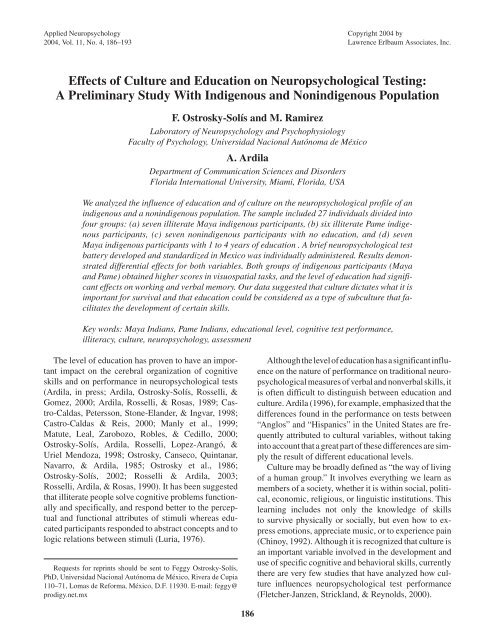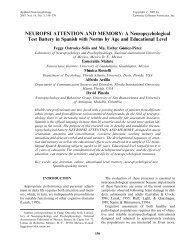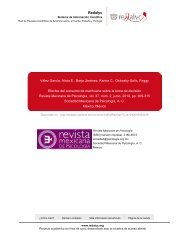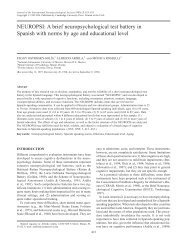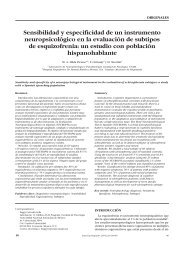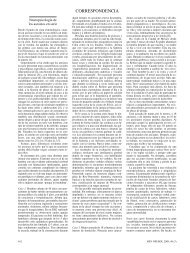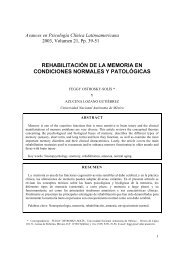Effects of Culture and Education on Neuropsychological Testing: A ...
Effects of Culture and Education on Neuropsychological Testing: A ...
Effects of Culture and Education on Neuropsychological Testing: A ...
Create successful ePaper yourself
Turn your PDF publications into a flip-book with our unique Google optimized e-Paper software.
OSTROSKY-SOLÍS, RAMIREZ, AND EDUCATION & ARDILA<br />
Applied Neuropsychology<br />
2004, Vol. 11, No. 4, 186–193<br />
Copyright 2004 by<br />
Lawrence Erlbaum Associates, Inc.<br />
<str<strong>on</strong>g>Effects</str<strong>on</strong>g> <str<strong>on</strong>g>of</str<strong>on</strong>g> <str<strong>on</strong>g>Culture</str<strong>on</strong>g> <str<strong>on</strong>g>and</str<strong>on</strong>g> <str<strong>on</strong>g>Educati<strong>on</strong></str<strong>on</strong>g> <strong>on</strong> <strong>Neuropsychological</strong> <strong>Testing</strong>:<br />
A Preliminary Study With Indigenous <str<strong>on</strong>g>and</str<strong>on</strong>g> N<strong>on</strong>indigenous Populati<strong>on</strong> CULTURE<br />
F. Ostrosky-Solís <str<strong>on</strong>g>and</str<strong>on</strong>g> M. Ramirez<br />
Laboratory <str<strong>on</strong>g>of</str<strong>on</strong>g> Neuropsychology <str<strong>on</strong>g>and</str<strong>on</strong>g> Psychophysiology<br />
Faculty <str<strong>on</strong>g>of</str<strong>on</strong>g> Psychology, Universidad Naci<strong>on</strong>al Autónoma de México<br />
A. Ardila<br />
Department <str<strong>on</strong>g>of</str<strong>on</strong>g> Communicati<strong>on</strong> Sciences <str<strong>on</strong>g>and</str<strong>on</strong>g> Disorders<br />
Florida Internati<strong>on</strong>al University, Miami, Florida, USA<br />
We analyzed the influence <str<strong>on</strong>g>of</str<strong>on</strong>g> educati<strong>on</strong> <str<strong>on</strong>g>and</str<strong>on</strong>g> <str<strong>on</strong>g>of</str<strong>on</strong>g> culture <strong>on</strong> the neuropsychological pr<str<strong>on</strong>g>of</str<strong>on</strong>g>ile <str<strong>on</strong>g>of</str<strong>on</strong>g> an<br />
indigenous <str<strong>on</strong>g>and</str<strong>on</strong>g> a n<strong>on</strong>indigenous populati<strong>on</strong>. The sample included 27 individuals divided into<br />
four groups: (a) seven illiterate Maya indigenous participants, (b) six illiterate Pame indigenous<br />
participants, (c) seven n<strong>on</strong>indigenous participants with no educati<strong>on</strong>, <str<strong>on</strong>g>and</str<strong>on</strong>g> (d) seven<br />
Maya indigenous participants with 1 to 4 years <str<strong>on</strong>g>of</str<strong>on</strong>g> educati<strong>on</strong> . A brief neuropsychological test<br />
battery developed <str<strong>on</strong>g>and</str<strong>on</strong>g> st<str<strong>on</strong>g>and</str<strong>on</strong>g>ardized in Mexico was individually administered. Results dem<strong>on</strong>strated<br />
differential effects for both variables. Both groups <str<strong>on</strong>g>of</str<strong>on</strong>g> indigenous participants (Maya<br />
<str<strong>on</strong>g>and</str<strong>on</strong>g> Pame) obtained higher scores in visuospatial tasks, <str<strong>on</strong>g>and</str<strong>on</strong>g> the level <str<strong>on</strong>g>of</str<strong>on</strong>g> educati<strong>on</strong> had significant<br />
effects <strong>on</strong> working <str<strong>on</strong>g>and</str<strong>on</strong>g> verbal memory. Our data suggested that culture dictates what it is<br />
important for survival <str<strong>on</strong>g>and</str<strong>on</strong>g> that educati<strong>on</strong> could be c<strong>on</strong>sidered as a type <str<strong>on</strong>g>of</str<strong>on</strong>g> subculture that facilitates<br />
the development <str<strong>on</strong>g>of</str<strong>on</strong>g> certain skills.<br />
Key words: Maya Indians, Pame Indians, educati<strong>on</strong>al level, cognitive test performance,<br />
illiteracy, culture, neuropsychology, assessment<br />
The level <str<strong>on</strong>g>of</str<strong>on</strong>g> educati<strong>on</strong> has proven to have an important<br />
impact <strong>on</strong> the cerebral organizati<strong>on</strong> <str<strong>on</strong>g>of</str<strong>on</strong>g> cognitive<br />
skills <str<strong>on</strong>g>and</str<strong>on</strong>g> <strong>on</strong> performance in neuropsychological tests<br />
(Ardila, in press; Ardila, Ostrosky-Solís, Rosselli, &<br />
Gomez, 2000; Ardila, Rosselli, & Rosas, 1989; Castro-Caldas,<br />
Peterss<strong>on</strong>, St<strong>on</strong>e-El<str<strong>on</strong>g>and</str<strong>on</strong>g>er, & Ingvar, 1998;<br />
Castro-Caldas & Reis, 2000; Manly et al., 1999;<br />
Matute, Leal, Zarobozo, Robles, & Cedillo, 2000;<br />
Ostrosky-Solís, Ardila, Rosselli, Lopez-Arangó, &<br />
Uriel Mendoza, 1998; Ostrosky, Canseco, Quintanar,<br />
Navarro, & Ardila, 1985; Ostrosky et al., 1986;<br />
Ostrosky-Solís, 2002; Rosselli & Ardila, 2003;<br />
Rosselli, Ardila, & Rosas, 1990). It has been suggested<br />
that illiterate people solve cognitive problems functi<strong>on</strong>ally<br />
<str<strong>on</strong>g>and</str<strong>on</strong>g> specifically, <str<strong>on</strong>g>and</str<strong>on</strong>g> resp<strong>on</strong>d better to the perceptual<br />
<str<strong>on</strong>g>and</str<strong>on</strong>g> functi<strong>on</strong>al attributes <str<strong>on</strong>g>of</str<strong>on</strong>g> stimuli whereas educated<br />
participants resp<strong>on</strong>ded to abstract c<strong>on</strong>cepts <str<strong>on</strong>g>and</str<strong>on</strong>g> to<br />
logic relati<strong>on</strong>s between stimuli (Luria, 1976).<br />
Requests for reprints should be sent to Feggy Ostrosky-Solís,<br />
PhD, Universidad Naci<strong>on</strong>al Autónoma de México, Rivera de Cupia<br />
110–71, Lomas de Reforma, México, D.F. 11930. E-mail: feggy@<br />
prodigy.net.mx<br />
Althoughthelevel<str<strong>on</strong>g>of</str<strong>on</strong>g>educati<strong>on</strong>hasasignificantinfluence<br />
<strong>on</strong> the nature <str<strong>on</strong>g>of</str<strong>on</strong>g> performance <strong>on</strong> traditi<strong>on</strong>al neuropsychological<br />
measures <str<strong>on</strong>g>of</str<strong>on</strong>g> verbal <str<strong>on</strong>g>and</str<strong>on</strong>g> n<strong>on</strong>verbal skills, it<br />
is <str<strong>on</strong>g>of</str<strong>on</strong>g>ten difficult to distinguish between educati<strong>on</strong> <str<strong>on</strong>g>and</str<strong>on</strong>g><br />
culture. Ardila (1996), for example, emphasized that the<br />
differences found in the performance <strong>on</strong> tests between<br />
“Anglos” <str<strong>on</strong>g>and</str<strong>on</strong>g> “Hispanics” in the United States are frequently<br />
attributed to cultural variables, without taking<br />
into account that a great part <str<strong>on</strong>g>of</str<strong>on</strong>g> these differences are simply<br />
the result <str<strong>on</strong>g>of</str<strong>on</strong>g> different educati<strong>on</strong>al levels.<br />
<str<strong>on</strong>g>Culture</str<strong>on</strong>g> may be broadly defined as “the way <str<strong>on</strong>g>of</str<strong>on</strong>g> living<br />
<str<strong>on</strong>g>of</str<strong>on</strong>g> a human group.” It involves everything we learn as<br />
members <str<strong>on</strong>g>of</str<strong>on</strong>g> a society, whether it is within social, political,<br />
ec<strong>on</strong>omic, religious, or linguistic instituti<strong>on</strong>s. This<br />
learning includes not <strong>on</strong>ly the knowledge <str<strong>on</strong>g>of</str<strong>on</strong>g> skills<br />
to survive physically or socially, but even how to express<br />
emoti<strong>on</strong>s, appreciate music, or to experience pain<br />
(Chinoy, 1992). Although it is recognized that culture is<br />
an important variable involved in the development <str<strong>on</strong>g>and</str<strong>on</strong>g><br />
use <str<strong>on</strong>g>of</str<strong>on</strong>g> specific cognitive <str<strong>on</strong>g>and</str<strong>on</strong>g> behavioral skills, currently<br />
there are very few studies that have analyzed how culture<br />
influences neuropsychological test performance<br />
(Fletcher-Janzen, Strickl<str<strong>on</strong>g>and</str<strong>on</strong>g>, & Reynolds, 2000).<br />
186
CULTURE AND EDUCATION<br />
Informati<strong>on</strong> about neuropsychological test performance<br />
in Amerindian cultural groups is extremely limited.<br />
Just a few studies are found to date. P<strong>on</strong>tius<br />
(1989), for example, selected 19 adult nomadic Auca<br />
Indians <str<strong>on</strong>g>of</str<strong>on</strong>g> the Ecuatorian basin. A four-colored Kohs<br />
Block Design test was administered. Deficits in block<br />
design particularly related to representati<strong>on</strong>s <str<strong>on</strong>g>and</str<strong>on</strong>g> c<strong>on</strong>structi<strong>on</strong><br />
<str<strong>on</strong>g>of</str<strong>on</strong>g> certain intrapattern spatial relati<strong>on</strong>s <str<strong>on</strong>g>and</str<strong>on</strong>g><br />
graphic representati<strong>on</strong>al skills were found. P<strong>on</strong>tius<br />
(1995) hypothesized that this strategy is also observed<br />
in other hunting societies. Hunter-gatherer’s survival<br />
depends <strong>on</strong> prompt assessment <str<strong>on</strong>g>of</str<strong>on</strong>g> the salient shape <str<strong>on</strong>g>of</str<strong>on</strong>g><br />
prey <str<strong>on</strong>g>and</str<strong>on</strong>g> attackers.<br />
Recently, Ardila <str<strong>on</strong>g>and</str<strong>on</strong>g> Moreno (2001) evaluated a<br />
group <str<strong>on</strong>g>of</str<strong>on</strong>g> Arauco Indians in Colombia, using a neuropsychological<br />
test battery. Twenty participants were selected:<br />
12 men <str<strong>on</strong>g>and</str<strong>on</strong>g> 8 women. The age range was between<br />
8 <str<strong>on</strong>g>and</str<strong>on</strong>g> 30, <str<strong>on</strong>g>and</str<strong>on</strong>g> an educati<strong>on</strong> level between 0 <str<strong>on</strong>g>and</str<strong>on</strong>g> 6<br />
years. The adults were m<strong>on</strong>olingual (indigenous language)<br />
<str<strong>on</strong>g>and</str<strong>on</strong>g> illiterate; the minors were bilingual <str<strong>on</strong>g>and</str<strong>on</strong>g> educated.<br />
The battery with which they were assessed included<br />
the following: copying a cube, copying <str<strong>on</strong>g>and</str<strong>on</strong>g><br />
recalling the Rey–Osterrieth figure, the Spanish versi<strong>on</strong><br />
<str<strong>on</strong>g>of</str<strong>on</strong>g> the Wechsler Intelligence Scale for Children–Revised<br />
block design, identificati<strong>on</strong> <str<strong>on</strong>g>of</str<strong>on</strong>g> overlapped figures,<br />
identificati<strong>on</strong> <str<strong>on</strong>g>of</str<strong>on</strong>g> multiple choice figures, ideomotor<br />
praxis, drawing a map, spatial memory, verbal fluency,<br />
modified Wisc<strong>on</strong>sin Card Sorting Test, <str<strong>on</strong>g>and</str<strong>on</strong>g> a laterality<br />
questi<strong>on</strong>naire. The authors report that in some <str<strong>on</strong>g>of</str<strong>on</strong>g> the<br />
tests, the performance <str<strong>on</strong>g>of</str<strong>on</strong>g> the indigenous group was almost<br />
perfect (identificati<strong>on</strong> <str<strong>on</strong>g>of</str<strong>on</strong>g> overlapped figures <str<strong>on</strong>g>and</str<strong>on</strong>g><br />
ideomotor praxis skills), whereas their performance in<br />
other tests was impossible (cubes design, map drawing,<br />
Rey–Osterrieth Complex Figure copying, spatial memory,<br />
<str<strong>on</strong>g>and</str<strong>on</strong>g> modified Wisc<strong>on</strong>sin Card Sorting Test). They<br />
c<strong>on</strong>cluded that there are three variables that affected the<br />
performance <str<strong>on</strong>g>of</str<strong>on</strong>g> the participants: (a) educati<strong>on</strong>al level,<br />
in which a significant correlati<strong>on</strong> was found between<br />
the scoring in the test <str<strong>on</strong>g>and</str<strong>on</strong>g> this level; (b) cultural relevance,<br />
in which some tests were significant <str<strong>on</strong>g>and</str<strong>on</strong>g> important<br />
whereas others did not make sense <str<strong>on</strong>g>and</str<strong>on</strong>g> were impossible<br />
to underst<str<strong>on</strong>g>and</str<strong>on</strong>g>, <str<strong>on</strong>g>and</str<strong>on</strong>g> finally; (c) age, in which a<br />
significant associati<strong>on</strong> was found between the performance<br />
in the tests <str<strong>on</strong>g>and</str<strong>on</strong>g> this variable. One <str<strong>on</strong>g>of</str<strong>on</strong>g> the limitati<strong>on</strong>s<br />
<str<strong>on</strong>g>of</str<strong>on</strong>g> this study is that it included a small sample <str<strong>on</strong>g>of</str<strong>on</strong>g><br />
participants (n = 20) with different levels <str<strong>on</strong>g>of</str<strong>on</strong>g> educati<strong>on</strong><br />
(0–6 years), <str<strong>on</strong>g>and</str<strong>on</strong>g> a wide range <str<strong>on</strong>g>of</str<strong>on</strong>g> ages (8–30), <str<strong>on</strong>g>and</str<strong>on</strong>g> therefore<br />
it is not clear whether the results are due to effect <str<strong>on</strong>g>of</str<strong>on</strong>g><br />
culture, age, or differences in the educati<strong>on</strong>al level <str<strong>on</strong>g>of</str<strong>on</strong>g><br />
the participants.<br />
The limitati<strong>on</strong> <str<strong>on</strong>g>of</str<strong>on</strong>g> the studies performed to date is due<br />
to the fact that the effects <str<strong>on</strong>g>of</str<strong>on</strong>g> culture <str<strong>on</strong>g>and</str<strong>on</strong>g> educati<strong>on</strong> are<br />
sometimes difficult to separate. The purpose <str<strong>on</strong>g>of</str<strong>on</strong>g> this research<br />
was to analyze the influence <str<strong>on</strong>g>of</str<strong>on</strong>g> each <strong>on</strong>e <str<strong>on</strong>g>of</str<strong>on</strong>g> these<br />
variables (culture <str<strong>on</strong>g>and</str<strong>on</strong>g> educati<strong>on</strong>) while administering a<br />
neuropsychological test to an indigenous populati<strong>on</strong>.<br />
Participants<br />
Method<br />
The total sample included 27 individuals: 20 were illiterates<br />
<str<strong>on</strong>g>and</str<strong>on</strong>g> 7 had 1 to 4 years <str<strong>on</strong>g>of</str<strong>on</strong>g> educati<strong>on</strong>, with an average<br />
age <str<strong>on</strong>g>of</str<strong>on</strong>g> 54.60 years, with a range <str<strong>on</strong>g>of</str<strong>on</strong>g> 43 to 73 years.<br />
The illiterate sample was divided into three groups:<br />
seven Maya participants, six Pame, <str<strong>on</strong>g>and</str<strong>on</strong>g> seven n<strong>on</strong>indigenous.<br />
To further study how learning to read <str<strong>on</strong>g>and</str<strong>on</strong>g><br />
write affects the neuropsychological pr<str<strong>on</strong>g>of</str<strong>on</strong>g>ile, we studied<br />
a group <str<strong>on</strong>g>of</str<strong>on</strong>g> seven Maya participants who had 1 to 4 years<br />
<str<strong>on</strong>g>of</str<strong>on</strong>g> educati<strong>on</strong>. This group was compared to the seven<br />
illiterate Maya participants. The individuals were<br />
matched by age <str<strong>on</strong>g>and</str<strong>on</strong>g> educati<strong>on</strong>al level. The descriptive<br />
characteristics <str<strong>on</strong>g>of</str<strong>on</strong>g> the sample are shown in Table 1.<br />
The indigenous populati<strong>on</strong> under study lived in two<br />
different states <str<strong>on</strong>g>of</str<strong>on</strong>g> Mexico: the Maya culture that lived<br />
in the state <str<strong>on</strong>g>of</str<strong>on</strong>g> Yucatan <str<strong>on</strong>g>and</str<strong>on</strong>g> the Pame culture that lived in<br />
the state <str<strong>on</strong>g>of</str<strong>on</strong>g> San Luis Potosí. The Mayan language is<br />
spoken by 800,291 people (Instituto Naci<strong>on</strong>al de Estadística,<br />
Geografía e Informática, 2000). Mayas are<br />
the majority populati<strong>on</strong> in the state <str<strong>on</strong>g>of</str<strong>on</strong>g> Yucatan, outnumbering<br />
n<strong>on</strong>indigenous residents. Yucatan is the state.<br />
Table 1.<br />
Descriptive Characteristics <str<strong>on</strong>g>of</str<strong>on</strong>g> the Sample<br />
Age in Years<br />
Range <str<strong>on</strong>g>of</str<strong>on</strong>g><br />
Sex<br />
Level <str<strong>on</strong>g>of</str<strong>on</strong>g><br />
<str<strong>on</strong>g>Educati<strong>on</strong></str<strong>on</strong>g> (Years)<br />
n x SD Age (Years) M F X SD<br />
Pame illiterates 6 53.67 6.18 43–69 3 3 0 0.00<br />
Maya illiterates 7 58.43 8.88 43–73 5 2 0 0.00<br />
N<strong>on</strong>indigenous illiterates 7 57.71 9.06 43–71 2 5 0 0.00<br />
Maya 1–4 7 55.29 9.76 43–73 2 5 2.07 0.84<br />
Total 27 54.60 8.47 43–73 12 15 0.51 0.21<br />
187
OSTROSKY-SOLÍS, RAMIREZ, & ARDILA<br />
Mayan language is part <str<strong>on</strong>g>of</str<strong>on</strong>g> the Maya–Tot<strong>on</strong>aco group;<br />
this language is spoken by peninsular indigenous <str<strong>on</strong>g>and</str<strong>on</strong>g><br />
by a great number <str<strong>on</strong>g>of</str<strong>on</strong>g> mestizos or pers<strong>on</strong>s <str<strong>on</strong>g>of</str<strong>on</strong>g> mixed race,<br />
who use it as an interacti<strong>on</strong> element in their social relati<strong>on</strong>ships.<br />
Women use the Mayan language more than<br />
men, <str<strong>on</strong>g>and</str<strong>on</strong>g> the new generati<strong>on</strong>s speak Spanish more <str<strong>on</strong>g>of</str<strong>on</strong>g>ten<br />
than Mayan, because this language is used <strong>on</strong>ly at<br />
home (Instituto Naci<strong>on</strong>al Indigenista, 2002). The traditi<strong>on</strong>al<br />
Mayan houses have walls made <str<strong>on</strong>g>of</str<strong>on</strong>g> interwoven<br />
branches, with guano, palm leaves, or hay <strong>on</strong> top <str<strong>on</strong>g>of</str<strong>on</strong>g> a<br />
soil base. The furnishings are very simple; they generally<br />
c<strong>on</strong>sist <str<strong>on</strong>g>of</str<strong>on</strong>g> wooden chairs with leather seats, tree<br />
trunk benches, a table, <str<strong>on</strong>g>and</str<strong>on</strong>g> hammocks made <str<strong>on</strong>g>of</str<strong>on</strong>g> henequen<br />
or cott<strong>on</strong> thread. Their social organizati<strong>on</strong> is made<br />
up <str<strong>on</strong>g>of</str<strong>on</strong>g> municipal authorities that, together with the<br />
nojoch tata (chief), the (holy) escribientes or clerks,<br />
<str<strong>on</strong>g>and</str<strong>on</strong>g> the rezadores (people who pray), administer justice<br />
<str<strong>on</strong>g>and</str<strong>on</strong>g> solve the problems <str<strong>on</strong>g>of</str<strong>on</strong>g> the community.<br />
The Pame culture is a relatively small community integrated<br />
by 8,312 people who live in the state <str<strong>on</strong>g>of</str<strong>on</strong>g> San<br />
Luis Potosí. They call themselves xi úi, which means<br />
indigenous. The majority is fully bilingual (Pame-<br />
Spanish) <str<strong>on</strong>g>and</str<strong>on</strong>g> people are devoted to farming <str<strong>on</strong>g>and</str<strong>on</strong>g> basketry<br />
manufacturing for ec<strong>on</strong>omic survival. The traditi<strong>on</strong>al<br />
Pame houses have soil <str<strong>on</strong>g>and</str<strong>on</strong>g> wooden bases. They<br />
have <strong>on</strong>e to two rooms: <strong>on</strong>e is used as the kitchen <str<strong>on</strong>g>and</str<strong>on</strong>g><br />
the other is the bedroom. The furnishings are very simple;<br />
they generally c<strong>on</strong>sist <str<strong>on</strong>g>of</str<strong>on</strong>g> wooden chairs, a table,<br />
<str<strong>on</strong>g>and</str<strong>on</strong>g> a cloth mattress that is used as a bed. Their social<br />
organizati<strong>on</strong> is made up <str<strong>on</strong>g>of</str<strong>on</strong>g> municipal authorities who<br />
administer justice <str<strong>on</strong>g>and</str<strong>on</strong>g> solve the problems <str<strong>on</strong>g>of</str<strong>on</strong>g> the community.<br />
The n<strong>on</strong>indigenous sample was selected in Mexico<br />
City. This sample was made up <str<strong>on</strong>g>of</str<strong>on</strong>g> individuals born in<br />
the city, who did not speak any indigenous language,<br />
<str<strong>on</strong>g>and</str<strong>on</strong>g> who were merchants, workers, <str<strong>on</strong>g>and</str<strong>on</strong>g> domestic employees.<br />
The participants <str<strong>on</strong>g>of</str<strong>on</strong>g> this populati<strong>on</strong> were Spanish<br />
m<strong>on</strong>olinguals.<br />
Instruments<br />
The following battery was administered for the assessment<br />
<str<strong>on</strong>g>of</str<strong>on</strong>g> the participants.<br />
1. Clinical history—A neurologic <str<strong>on</strong>g>and</str<strong>on</strong>g> psychiatric<br />
screening questi<strong>on</strong>naire was used to rule out previous<br />
neurological <str<strong>on</strong>g>and</str<strong>on</strong>g> psychiatric c<strong>on</strong>diti<strong>on</strong>s, such as brain<br />
injury, cerebrovascular disease, epilepsy, Parkins<strong>on</strong>’s<br />
disease, psychiatric hospitalizati<strong>on</strong>s, <str<strong>on</strong>g>and</str<strong>on</strong>g> so forth.<br />
2. Guide for the Explorati<strong>on</strong>, Comprehensi<strong>on</strong> <str<strong>on</strong>g>and</str<strong>on</strong>g><br />
Expressi<strong>on</strong> <str<strong>on</strong>g>of</str<strong>on</strong>g> Basic Spanish (Ostrosky-Solís et al.,<br />
2002)—This was applied to select participants who<br />
were completely bilingual with an adequate comprehensi<strong>on</strong><br />
<str<strong>on</strong>g>and</str<strong>on</strong>g> expressi<strong>on</strong> <str<strong>on</strong>g>of</str<strong>on</strong>g> Spanish. A score <str<strong>on</strong>g>of</str<strong>on</strong>g> 70 <str<strong>on</strong>g>and</str<strong>on</strong>g><br />
above is equivalent to “completely bilingual” (Maya-<br />
Spanish <str<strong>on</strong>g>and</str<strong>on</strong>g> Pame-Spanish).<br />
3. NEUROPSI neuropsychological test battery—<br />
The NEUROPSI neuropsychological test battery is a<br />
brief neuropsychological test battery developed <str<strong>on</strong>g>and</str<strong>on</strong>g><br />
st<str<strong>on</strong>g>and</str<strong>on</strong>g>ardized in Mexico (Ostrosky, Ardila, & Rosselli,<br />
1997, 1999). Table 2 presents a descripti<strong>on</strong> <str<strong>on</strong>g>of</str<strong>on</strong>g> the test.<br />
In total, 26 different scores are obtained. The maximum<br />
total score is 130. Administrati<strong>on</strong> time is 25 to 30 min.<br />
Normative scores were obtained in a sample <str<strong>on</strong>g>of</str<strong>on</strong>g> 1,680<br />
participants, corresp<strong>on</strong>ding to four age ranges (16–30,<br />
31–50, 51–65, <str<strong>on</strong>g>and</str<strong>on</strong>g> 66–85 years) <str<strong>on</strong>g>and</str<strong>on</strong>g> four educati<strong>on</strong>al<br />
levels (illiterates, 1–4, 5–9, <str<strong>on</strong>g>and</str<strong>on</strong>g> more than 10 years<br />
<str<strong>on</strong>g>of</str<strong>on</strong>g> formal educati<strong>on</strong>; Ostrosky et al., 1999). The<br />
NEUROPSI Manual distinguishes four levels <str<strong>on</strong>g>of</str<strong>on</strong>g> performance<br />
by age <str<strong>on</strong>g>and</str<strong>on</strong>g> by educati<strong>on</strong>al level: normal (within<br />
1 st<str<strong>on</strong>g>and</str<strong>on</strong>g>ard deviati<strong>on</strong>), mildly abnormal (between 1 <str<strong>on</strong>g>and</str<strong>on</strong>g><br />
2 st<str<strong>on</strong>g>and</str<strong>on</strong>g>ard deviati<strong>on</strong>s), moderately abnormal (between<br />
2 <str<strong>on</strong>g>and</str<strong>on</strong>g> 3 st<str<strong>on</strong>g>and</str<strong>on</strong>g>ard deviati<strong>on</strong>s), <str<strong>on</strong>g>and</str<strong>on</strong>g> severely abnormal<br />
(over 3 st<str<strong>on</strong>g>and</str<strong>on</strong>g>ard deviati<strong>on</strong>s with regard to the means<br />
scores in that age <str<strong>on</strong>g>and</str<strong>on</strong>g> educati<strong>on</strong> group). Participants<br />
were compared with the norms corresp<strong>on</strong>ding to their<br />
educati<strong>on</strong>al level (illiterates or 1–4 years <str<strong>on</strong>g>of</str<strong>on</strong>g> formal educati<strong>on</strong>).<br />
The NEUROPSI is sensitive to cognitive alterati<strong>on</strong>s<br />
associated with several clinical groups. An index<br />
<str<strong>on</strong>g>of</str<strong>on</strong>g> 83.53% <str<strong>on</strong>g>of</str<strong>on</strong>g> sensitivity <str<strong>on</strong>g>and</str<strong>on</strong>g> 82.07% <str<strong>on</strong>g>of</str<strong>on</strong>g> specificity has<br />
been reported in patients with mild <str<strong>on</strong>g>and</str<strong>on</strong>g> moderate dementia<br />
(Mejia, Gutierrez, Villa & Ostrosky-Solís,<br />
2004; Ostrosky-Solís et al., 1997).<br />
Procedure<br />
The following inclusi<strong>on</strong> criteria were used: (a) scoring<br />
equal or above 70 in the Guide for the Explorati<strong>on</strong>,<br />
Comprehensi<strong>on</strong> <str<strong>on</strong>g>and</str<strong>on</strong>g> Expressi<strong>on</strong> <str<strong>on</strong>g>of</str<strong>on</strong>g> Basic Spanish (Ostrosky-Solís<br />
et al., 2002); <str<strong>on</strong>g>and</str<strong>on</strong>g> (b) the participants had to<br />
be functi<strong>on</strong>ally independent, without history <str<strong>on</strong>g>of</str<strong>on</strong>g> neurological<br />
<str<strong>on</strong>g>and</str<strong>on</strong>g> psychiatric c<strong>on</strong>diti<strong>on</strong>s, such as brain injury,<br />
cerebrovascular disease, epilepsy, Parkins<strong>on</strong>’s disease,<br />
psychiatric hospitalizati<strong>on</strong>s, <str<strong>on</strong>g>and</str<strong>on</strong>g> so forth. A brief<br />
screening questi<strong>on</strong>naire was administered to all the<br />
participants.<br />
The participati<strong>on</strong> <str<strong>on</strong>g>of</str<strong>on</strong>g> the participants was voluntary.<br />
The assessment was explained to the participants <str<strong>on</strong>g>and</str<strong>on</strong>g><br />
they gave their oral c<strong>on</strong>sent. For the Maya <str<strong>on</strong>g>and</str<strong>on</strong>g> Pame<br />
sample, the administrati<strong>on</strong> <str<strong>on</strong>g>of</str<strong>on</strong>g> the instruments was d<strong>on</strong>e<br />
individually in a place chosen by the participants where<br />
they felt at ease.(i.e., in their house or below the shadow<br />
<str<strong>on</strong>g>of</str<strong>on</strong>g> a tree, but noisy places were avoided). For the n<strong>on</strong>-<br />
188
Table 2. NEUROPSI: A Brief <strong>Neuropsychological</strong> Test Battery Developed <str<strong>on</strong>g>and</str<strong>on</strong>g> St<str<strong>on</strong>g>and</str<strong>on</strong>g>ardized in Mexico (Ostrosky, Ardila & Rosselli, 1997, 1999)<br />
SUBTEST CONTENT SCORE<br />
Orientati<strong>on</strong> Time (day, m<strong>on</strong>th, <str<strong>on</strong>g>and</str<strong>on</strong>g> year), place (city <str<strong>on</strong>g>and</str<strong>on</strong>g> specific place), <str<strong>on</strong>g>and</str<strong>on</strong>g> pers<strong>on</strong> (how old are you?). 6<br />
Attenti<strong>on</strong> <str<strong>on</strong>g>and</str<strong>on</strong>g><br />
c<strong>on</strong>centrati<strong>on</strong><br />
Digits backward: up to six digits.<br />
Visual detecti<strong>on</strong>: In a sheet, which includes 16 different figures each, <strong>on</strong>e repeated 16 times, the participants are requested to cross out those<br />
figures equal to the <strong>on</strong>e presented as a model. The 16 matching figures are equally distributed at the right <str<strong>on</strong>g>and</str<strong>on</strong>g> at the left visual fields. The test is<br />
suspended after 1 min.<br />
27<br />
Verbal memory:<br />
Encoding <str<strong>on</strong>g>and</str<strong>on</strong>g><br />
delay recall<br />
20 minus 3: 5 c<strong>on</strong>secutive times.<br />
Immediate recall: Six comm<strong>on</strong> nouns corresp<strong>on</strong>ding to three different semantic categories (animals, fruits, <str<strong>on</strong>g>and</str<strong>on</strong>g> body parts) are presented three<br />
times. After each presentati<strong>on</strong>, the participants repeats those words that he or she remembers. Intrusi<strong>on</strong>s, perseverati<strong>on</strong>s, recency, <str<strong>on</strong>g>and</str<strong>on</strong>g> primacy<br />
effects are noted.<br />
Delay recall: Sp<strong>on</strong>taneous recall.<br />
Cue recall: Recall by categories (animals, fruits, <str<strong>on</strong>g>and</str<strong>on</strong>g> body parts).<br />
Visuospatial copy Copy <str<strong>on</strong>g>of</str<strong>on</strong>g> a semicomplex figure: A figure similar to the Rey–Osterrieth Complex Figure, but notoriously simpler, is presented to the participant. The 24<br />
<str<strong>on</strong>g>and</str<strong>on</strong>g> delay recall participant is instructed to copy the figure at his or her best.<br />
Recall <str<strong>on</strong>g>of</str<strong>on</strong>g> the semi-complex figure.<br />
Language Naming: Eight different line drawing figures are presented to be named. 31<br />
Repetiti<strong>on</strong>: The participant is asked to repeat <strong>on</strong>e m<strong>on</strong>osyllabic word, <strong>on</strong>e three-syllabic word, <strong>on</strong>e phrase with three words, <str<strong>on</strong>g>and</str<strong>on</strong>g> <strong>on</strong>e seven word<br />
sentence.<br />
Comprehensi<strong>on</strong>: On a sheet <str<strong>on</strong>g>of</str<strong>on</strong>g> paper, two circles (small <str<strong>on</strong>g>and</str<strong>on</strong>g> large) <str<strong>on</strong>g>and</str<strong>on</strong>g> two squares (small <str<strong>on</strong>g>and</str<strong>on</strong>g> large) are drawn. Six c<strong>on</strong>secutive comm<str<strong>on</strong>g>and</str<strong>on</strong>g>s, similar<br />
to those used in the Token Test, are given to the participant.<br />
Semantic verbal fluency (animals).<br />
Ph<strong>on</strong>ological verbal fluency (words beginning with the letter F).<br />
Reading: The participant is asked to read aloud a short paragraph.<br />
Writing: To write under dictati<strong>on</strong> a six-word sentence, <str<strong>on</strong>g>and</str<strong>on</strong>g> to write by copy a different six-word sentence.<br />
Ejecutive Functi<strong>on</strong> C<strong>on</strong>ceptual functi<strong>on</strong>s<br />
Similarities: Three pairs <str<strong>on</strong>g>of</str<strong>on</strong>g> words (e.g., orange-pear) are presented to find the similarity.<br />
Calculati<strong>on</strong> abilities: Three simple arithmetical problems are presented.<br />
Sequences: The participant is asked to c<strong>on</strong>tinue a sequence <str<strong>on</strong>g>of</str<strong>on</strong>g> figures drawn <strong>on</strong> paper (what figure c<strong>on</strong>tinues?).<br />
Motor functi<strong>on</strong>s<br />
Changing the positi<strong>on</strong> <str<strong>on</strong>g>of</str<strong>on</strong>g> the h<str<strong>on</strong>g>and</str<strong>on</strong>g>: To repeat three positi<strong>on</strong>s with the h<str<strong>on</strong>g>and</str<strong>on</strong>g> (right <str<strong>on</strong>g>and</str<strong>on</strong>g> left). The model is presented by the examiner up to three<br />
times. Alternating the movements <str<strong>on</strong>g>of</str<strong>on</strong>g> the h<str<strong>on</strong>g>and</str<strong>on</strong>g>s: To alternate the positi<strong>on</strong> <str<strong>on</strong>g>of</str<strong>on</strong>g> the h<str<strong>on</strong>g>and</str<strong>on</strong>g>s (right h<str<strong>on</strong>g>and</str<strong>on</strong>g> close, left h<str<strong>on</strong>g>and</str<strong>on</strong>g> open, <str<strong>on</strong>g>and</str<strong>on</strong>g> to switch).<br />
Opposite reacti<strong>on</strong>s: If the examiner shows the finger, the participant must show the fist; if the examiner shows the fist, the participant must show<br />
the finger.<br />
TOTAL 130<br />
24<br />
189
OSTROSKY-SOLÍS, RAMIREZ, & ARDILA<br />
indigenous sample, administrati<strong>on</strong> was d<strong>on</strong>e individually<br />
in a separate room within the university setting.<br />
Statistical Analysis<br />
Descriptive statistics were obtained for each <strong>on</strong>e <str<strong>on</strong>g>of</str<strong>on</strong>g><br />
the neuropsychological variables per group. A Kruskal-Wallis<br />
analysis was used to compare the effect <str<strong>on</strong>g>of</str<strong>on</strong>g><br />
culture (Pame, Maya, <str<strong>on</strong>g>and</str<strong>on</strong>g> n<strong>on</strong>indigenous with no educati<strong>on</strong>)<br />
<str<strong>on</strong>g>and</str<strong>on</strong>g> a t test for independent groups was used to<br />
compare the effects <str<strong>on</strong>g>of</str<strong>on</strong>g> educati<strong>on</strong> <str<strong>on</strong>g>of</str<strong>on</strong>g> Maya illiterates<br />
versus Maya indigenous with 1 to 4 years <str<strong>on</strong>g>of</str<strong>on</strong>g> educati<strong>on</strong>..<br />
The significance level was established at p < 0.05 for all<br />
the statistical analyses.<br />
Results<br />
The effects <str<strong>on</strong>g>of</str<strong>on</strong>g> the culture, Pame <str<strong>on</strong>g>and</str<strong>on</strong>g> Maya versus<br />
n<strong>on</strong>indigenous without educati<strong>on</strong>, can be observed in<br />
Table 3. This table shows the mean, st<str<strong>on</strong>g>and</str<strong>on</strong>g>ard deviati<strong>on</strong>,<br />
<str<strong>on</strong>g>and</str<strong>on</strong>g> significance level obtained in the NEUROPSI subtests.<br />
Significant differences were found <strong>on</strong>ly in 5 out<br />
<str<strong>on</strong>g>of</str<strong>on</strong>g> the 21 subtests. The differences were found in the<br />
following: copy <str<strong>on</strong>g>and</str<strong>on</strong>g> delay recall <str<strong>on</strong>g>of</str<strong>on</strong>g> the semicomplex<br />
figure, h<str<strong>on</strong>g>and</str<strong>on</strong>g> positi<strong>on</strong>, <str<strong>on</strong>g>and</str<strong>on</strong>g> immediate <str<strong>on</strong>g>and</str<strong>on</strong>g> delayed verbal<br />
memory. Both indigenous participants scored higher<br />
in copy <str<strong>on</strong>g>and</str<strong>on</strong>g> delay recall <str<strong>on</strong>g>of</str<strong>on</strong>g> the semicomplex figure<br />
<str<strong>on</strong>g>and</str<strong>on</strong>g> in h<str<strong>on</strong>g>and</str<strong>on</strong>g> positi<strong>on</strong> <str<strong>on</strong>g>and</str<strong>on</strong>g> lower scores than the n<strong>on</strong>indigenous<br />
in immediate <str<strong>on</strong>g>and</str<strong>on</strong>g> delayed verbal memory.<br />
Table 4 presents the neuropsychological pr<str<strong>on</strong>g>of</str<strong>on</strong>g>ile <str<strong>on</strong>g>of</str<strong>on</strong>g><br />
the Maya indigenous populati<strong>on</strong> with no educati<strong>on</strong> versus<br />
the Maya indigenous populati<strong>on</strong> with 1 to 4 years <str<strong>on</strong>g>of</str<strong>on</strong>g><br />
educati<strong>on</strong>. The group with 1 to 4 years <str<strong>on</strong>g>of</str<strong>on</strong>g> educati<strong>on</strong> obtained<br />
higher scores <strong>on</strong> the following: visual detecti<strong>on</strong>,<br />
copy <str<strong>on</strong>g>and</str<strong>on</strong>g> delay recall <str<strong>on</strong>g>of</str<strong>on</strong>g> the semicomplex figure, delay<br />
verbal memory in sp<strong>on</strong>taneous <str<strong>on</strong>g>and</str<strong>on</strong>g> cue recall, <str<strong>on</strong>g>and</str<strong>on</strong>g> in<br />
the total NEUROPSI.<br />
Discussi<strong>on</strong><br />
Examining the influence <str<strong>on</strong>g>of</str<strong>on</strong>g> the cultural factor, the results<br />
obtained in this research indicate that illiterate indigenous<br />
(Pame <str<strong>on</strong>g>and</str<strong>on</strong>g> Maya) people show a better executi<strong>on</strong><br />
in visuoperceptual <str<strong>on</strong>g>and</str<strong>on</strong>g> c<strong>on</strong>structive tasks (copy <str<strong>on</strong>g>of</str<strong>on</strong>g><br />
the semicomplex figure <str<strong>on</strong>g>and</str<strong>on</strong>g> h<str<strong>on</strong>g>and</str<strong>on</strong>g> positi<strong>on</strong>), but obtained<br />
lower scores <strong>on</strong> a subtest related to immediate<br />
<str<strong>on</strong>g>and</str<strong>on</strong>g> delayed verbal memory. These results suggest that<br />
the cultural envir<strong>on</strong>ment where the indigenous people<br />
live may have a significant influence in their cognitive<br />
Table 3. Mean, st<str<strong>on</strong>g>and</str<strong>on</strong>g>ard deviati<strong>on</strong>, <str<strong>on</strong>g>and</str<strong>on</strong>g> significance level obtained in the NEUROPSI subtests for illiterate groups Pame, Maya,<br />
<str<strong>on</strong>g>and</str<strong>on</strong>g> n<strong>on</strong>indigenous.<br />
Subtest<br />
190<br />
Pame Illiterates<br />
n = 6<br />
Maya Illiterates<br />
n = 7<br />
N<strong>on</strong>indigenous<br />
Illiterates n = 7<br />
Orientati<strong>on</strong> time 2.83 (0.40) 2.86 (0.37) 2.43 (0.78) .366 —<br />
Orientati<strong>on</strong> space 2.00 (0.00) 2.00 (0.00) 1.86 (0.37) .395 —<br />
Orientati<strong>on</strong> pers<strong>on</strong> 0.83 (0.40) 1.00 (0.00) 1.00 (0.00) .311 —<br />
Digit backwards 2.17 (1.94) 1.43 (1.39) 1.57 (1.13) .934 —<br />
Visual detecti<strong>on</strong> 10.33 (3.77) 6.43 (3.15) 9.71 (4.75) .242 —<br />
20 minus 3 2.17 (2.48) 1.29 (2.21) 1.57 (2.07) .751 —<br />
Immediate verbal memory 3.00 (0.54) 2.86 (1.34) 4.29 (0.75) .045 N vs. M, P<br />
Copy <str<strong>on</strong>g>of</str<strong>on</strong>g> semicomplex figure 9.73 (1.08) 8.95 (0.89) 6.21 (1.41) .002 P,M vs. N<br />
Naming 6.67 (1.03) 7.71 (0.48) 7.57 (0.78) .070 —<br />
Repetiti<strong>on</strong> 3.67 (0.56) 3.43 (0.53) 3.86 (0.37) .260 —<br />
Comprehensi<strong>on</strong> 4.00 (1.26) 4.14 (0.69) 4.14 (1.57) .908 —<br />
Semantic fluency 11.83 (4.49) 11.00 (2.58) 12.00 (2.44) .910 —<br />
Similarities 2.50 (2.16) 3.57 (1.90) 1.86 (1.67) .203 —<br />
H<str<strong>on</strong>g>and</str<strong>on</strong>g> positi<strong>on</strong> 2.33 (0.81) 1.71 (0.48) 1.00 (0.99) .046 P,M vs. N<br />
Alternating movements 0.67 (0.51) 0.71 (0.75) 0.57 (0.53) .937 —<br />
Opposite reacti<strong>on</strong>s 1.67 (0.51) 1.43 (0.78) 1.29 (0.75) .636 —<br />
Delayed visuospatial memory 8.16 (0.68) 7.78 (1.34) 4.14 (2.1) .002 P,M vs. N<br />
Delayed verbal memory 0.83 (2.04) 0.14 (0.37) 2.57 (1.90) .013 N vs. P,M<br />
Cue recall 2.33 (1.36) 1.43 (1.39) 2.85 (2.30) .446 —<br />
Recogniti<strong>on</strong> recall 5.83 (0.48) 5.57 (0.53) 5.86 (0.37) .417 —<br />
Note. Significant differences were found <strong>on</strong>ly in 5 <str<strong>on</strong>g>of</str<strong>on</strong>g> the 21 subtests: Both indigenous participants scored higher in copy <str<strong>on</strong>g>and</str<strong>on</strong>g> delay recall <str<strong>on</strong>g>of</str<strong>on</strong>g> the semicomplex<br />
<str<strong>on</strong>g>and</str<strong>on</strong>g> h<str<strong>on</strong>g>and</str<strong>on</strong>g> positi<strong>on</strong> <str<strong>on</strong>g>and</str<strong>on</strong>g> lower scores than the n<strong>on</strong>indigenous in immediate <str<strong>on</strong>g>and</str<strong>on</strong>g> delay verbal memory.<br />
N = n<strong>on</strong>indigenous; M = Maya; P = Pame.<br />
* p = .05. ** p = .01.<br />
F
CULTURE AND EDUCATION<br />
Table 4.<br />
<str<strong>on</strong>g>Effects</str<strong>on</strong>g> <str<strong>on</strong>g>of</str<strong>on</strong>g> educati<strong>on</strong> <strong>on</strong> the cognitive pr<str<strong>on</strong>g>of</str<strong>on</strong>g>ile <str<strong>on</strong>g>of</str<strong>on</strong>g> the Maya indigenous participants.<br />
Subtest<br />
Mayas Illiterate<br />
n = 7<br />
x ± s.d.<br />
Mayas 1–4<br />
n = 7<br />
x ± s.d. Test P<br />
Orientati<strong>on</strong> time 2.86 ± 0.38 2.86 ± 0.37 .000 1.000<br />
Orientati<strong>on</strong> space 2.00 ± 0.00 2.00 ± 0.00 — —<br />
Orientati<strong>on</strong> pers<strong>on</strong> 1.00 ± 0.00 0.71 ± 0.48 1.549 .172<br />
Digit backwards 1.43 ± 1.40 2.57 ± 0.78 –1.886 .090<br />
Visual detecti<strong>on</strong> 6.43 ± 3.15 11.71 ± 5.64 –2.162 .056<br />
20 minus 3 1.29 ± 2.21 3.14 ± 2.41 –1.501 .159<br />
Immediate verbal memory 2.86 ± 1.35 3.86 ± 1.06 –1.540 .151<br />
Copy <str<strong>on</strong>g>of</str<strong>on</strong>g> semicomplex figure 8.35 ± 0.90 9.57 ± 2.14 –1.379 .205<br />
Naming 7.71 ± 0.49 7.86 ± 0.37 –.612 .552<br />
Repetiti<strong>on</strong> 3.43 ± 0.53 3.71 ± 0.48 –1.044 .317<br />
Comprehensi<strong>on</strong> 4.14 ± 0.69 4.71 ± 0.75 –1.477 .166<br />
Semantic fluency 11.00 ± 2.58 12.71 ± 1.97 –1.395 .190<br />
Similarities 3.57 ± 1.90 3.14 ± 1.86 .926 .678<br />
H<str<strong>on</strong>g>and</str<strong>on</strong>g> positi<strong>on</strong> 1.71 ± 0.49 1.86 ± 1.77 –2.06 .843<br />
Alternating movements 0.71 ± 0.76 0.71 ± 0.95 .000 1.000<br />
Opposite reacti<strong>on</strong>s 1.43 ± 0.79 1.71 ± 0.75 –.693 .502<br />
Delayed visuospatial memory 6.78 ± 1.34 8.57 ± 3.15 –1.377 .205<br />
Delayed verbal memory 0.14 ± 0.38 2.86 ± 2.19 –3.227 .017<br />
Cue recall 1.43 ± 1.40 3.86 ± 2.11 –2.534 .026<br />
Recogniti<strong>on</strong> recall 5.57 ± 0.53 5.00 ± 1.14 1.000 3.48<br />
Note. Mean, st<str<strong>on</strong>g>and</str<strong>on</strong>g>ard deviati<strong>on</strong>, <str<strong>on</strong>g>and</str<strong>on</strong>g> significance level obtained in the NEUROPSI subtests for illiterate indigenous participants <str<strong>on</strong>g>and</str<strong>on</strong>g> indigenous participants<br />
with 1 to 4 years <str<strong>on</strong>g>of</str<strong>on</strong>g> educati<strong>on</strong>. The group with 1 to 4 years <str<strong>on</strong>g>of</str<strong>on</strong>g> educati<strong>on</strong> obtained higher scores <strong>on</strong> delay verbal memory in sp<strong>on</strong>taneous <str<strong>on</strong>g>and</str<strong>on</strong>g> cue recall.<br />
organizati<strong>on</strong> <str<strong>on</strong>g>and</str<strong>on</strong>g> therefore, in the expressi<strong>on</strong> <str<strong>on</strong>g>of</str<strong>on</strong>g> their<br />
skills. As a matter <str<strong>on</strong>g>of</str<strong>on</strong>g> fact, their culture dem<str<strong>on</strong>g>and</str<strong>on</strong>g>s the use<br />
<str<strong>on</strong>g>of</str<strong>on</strong>g> visuospatial skills because they are people devoted to<br />
farming <str<strong>on</strong>g>and</str<strong>on</strong>g> basketry manufacturing for ec<strong>on</strong>omic survival.<br />
Nevertheless, delayed verbal memory skills are<br />
probably not used c<strong>on</strong>stantly or dem<str<strong>on</strong>g>and</str<strong>on</strong>g>ed in their envir<strong>on</strong>ment.<br />
On the c<strong>on</strong>trary, n<strong>on</strong>indigenous participants<br />
that live in the city probably require more verbal memory<br />
than visuospatial skills, <str<strong>on</strong>g>and</str<strong>on</strong>g> therefore scores in verbal<br />
memory tests are higher.<br />
These results c<strong>on</strong>cur with Ardila <str<strong>on</strong>g>and</str<strong>on</strong>g> Moreno<br />
(2001), who found in their study <strong>on</strong> Arauco indigenous<br />
participants, who are devoted to fishing <str<strong>on</strong>g>and</str<strong>on</strong>g> hunting, a<br />
good executi<strong>on</strong> in ideomotor skills. However, the opposite<br />
was found when copying figures: they reported a<br />
poor performance. In this study, we found that the performance<br />
<str<strong>on</strong>g>of</str<strong>on</strong>g> indigenous participants was above the<br />
n<strong>on</strong>indigenous (Mexico City) participants. These differences<br />
are probably due to the dissimilar dem<str<strong>on</strong>g>and</str<strong>on</strong>g>s <str<strong>on</strong>g>of</str<strong>on</strong>g><br />
the envir<strong>on</strong>ment.<br />
<str<strong>on</strong>g>Culture</str<strong>on</strong>g> intervenes in the development <str<strong>on</strong>g>and</str<strong>on</strong>g> use <str<strong>on</strong>g>of</str<strong>on</strong>g><br />
some cognitive processes. <str<strong>on</strong>g>Educati<strong>on</strong></str<strong>on</strong>g> also influences<br />
the reinforcement <str<strong>on</strong>g>of</str<strong>on</strong>g> certain cognitive skills. It has been<br />
said that educati<strong>on</strong> is not limited to the acquisiti<strong>on</strong> <str<strong>on</strong>g>of</str<strong>on</strong>g><br />
reading <str<strong>on</strong>g>and</str<strong>on</strong>g> writing (<str<strong>on</strong>g>and</str<strong>on</strong>g> other types <str<strong>on</strong>g>of</str<strong>on</strong>g> knowledge); it<br />
also requires the practical use <str<strong>on</strong>g>and</str<strong>on</strong>g> adaptati<strong>on</strong> <str<strong>on</strong>g>of</str<strong>on</strong>g> such<br />
skills to the c<strong>on</strong>texts <str<strong>on</strong>g>and</str<strong>on</strong>g> situati<strong>on</strong>s where they are required<br />
(Ardila, 1996, in press; Manly et al., 1999;<br />
Morais, Kolinsky, Alegria, & Scliar-Cabral, 1998).<br />
To determine the influence <str<strong>on</strong>g>of</str<strong>on</strong>g> educati<strong>on</strong> <strong>on</strong> the cognitive<br />
pr<str<strong>on</strong>g>of</str<strong>on</strong>g>ile <str<strong>on</strong>g>of</str<strong>on</strong>g> the illiterate Maya group <strong>on</strong>ce members<br />
acquired basic reading <str<strong>on</strong>g>and</str<strong>on</strong>g> writing skills, we compared<br />
the neuropsychological pr<str<strong>on</strong>g>of</str<strong>on</strong>g>ile <str<strong>on</strong>g>of</str<strong>on</strong>g> illiterate versus<br />
the pr<str<strong>on</strong>g>of</str<strong>on</strong>g>ile <str<strong>on</strong>g>of</str<strong>on</strong>g> participants with 1 to 4 years <str<strong>on</strong>g>of</str<strong>on</strong>g> formal educati<strong>on</strong>.<br />
We found significant differences in favor <str<strong>on</strong>g>of</str<strong>on</strong>g> the<br />
participants with 1 to 4 years <str<strong>on</strong>g>of</str<strong>on</strong>g> schooling in attenti<strong>on</strong><br />
<str<strong>on</strong>g>and</str<strong>on</strong>g> visuoperceptual processing (visual detecti<strong>on</strong>, copy<br />
<str<strong>on</strong>g>of</str<strong>on</strong>g> a figure), visual <str<strong>on</strong>g>and</str<strong>on</strong>g> verbal memory (delay recall <str<strong>on</strong>g>of</str<strong>on</strong>g><br />
complex figure, verbal memory), <str<strong>on</strong>g>and</str<strong>on</strong>g> in total<br />
NEUROPSI score. These data show that even if it is<br />
true that culture influences the development <str<strong>on</strong>g>and</str<strong>on</strong>g> use <str<strong>on</strong>g>of</str<strong>on</strong>g><br />
certain skills (e.g., visuospatial <str<strong>on</strong>g>and</str<strong>on</strong>g> h<str<strong>on</strong>g>and</str<strong>on</strong>g> positi<strong>on</strong>), educati<strong>on</strong><br />
also affects cognitive test performance. Results<br />
lead us to suppose that educati<strong>on</strong> relates with the reinforcement<br />
<str<strong>on</strong>g>of</str<strong>on</strong>g> some specific skills such as attenti<strong>on</strong> <str<strong>on</strong>g>and</str<strong>on</strong>g><br />
memory abilities.<br />
The former data agree with several investigati<strong>on</strong>s<br />
that have found lower performance in illiterates in<br />
memory tasks <str<strong>on</strong>g>and</str<strong>on</strong>g> digit retenti<strong>on</strong> (e.g., Ardila in press;<br />
Ardila et al., 2000; Ardila et al., 1989; Castro-Caldas &<br />
Reis, 2000; Ostrosky et al., 1999; Ostrosky-Solís,<br />
Ardila, Rosselli, Lopez-Arango, & Uriel Mendoza,<br />
191
OSTROSKY-SOLÍS, RAMIREZ, & ARDILA<br />
1998; Rosselli et al., 1990). As Morais <str<strong>on</strong>g>and</str<strong>on</strong>g> Kolinsky<br />
(2000) have pointed out, the written language <str<strong>on</strong>g>and</str<strong>on</strong>g> its inherent<br />
characteristics have deep c<strong>on</strong>sequences <strong>on</strong> the<br />
ability to process linguistic <str<strong>on</strong>g>and</str<strong>on</strong>g> n<strong>on</strong>linguistic informati<strong>on</strong>.<br />
For example, the linguistic domain affects the<br />
ph<strong>on</strong>ological <str<strong>on</strong>g>and</str<strong>on</strong>g> lexical knowledge; semantics influences<br />
the ability to categorize <str<strong>on</strong>g>and</str<strong>on</strong>g> c<strong>on</strong>ceptualize, as<br />
well as in the strategies used for codificati<strong>on</strong> <str<strong>on</strong>g>and</str<strong>on</strong>g> recall<br />
during memory, <str<strong>on</strong>g>and</str<strong>on</strong>g> in executive functi<strong>on</strong>s as expressed<br />
in selective attenti<strong>on</strong> <str<strong>on</strong>g>and</str<strong>on</strong>g> inhibiti<strong>on</strong> <str<strong>on</strong>g>of</str<strong>on</strong>g> inappropriate resp<strong>on</strong>ses.<br />
Likewise, educati<strong>on</strong> provides training <str<strong>on</strong>g>and</str<strong>on</strong>g> improves<br />
the ability to process informati<strong>on</strong> from c<strong>on</strong>crete<br />
stimulus to a model <str<strong>on</strong>g>of</str<strong>on</strong>g> abstract representati<strong>on</strong> <str<strong>on</strong>g>of</str<strong>on</strong>g> the<br />
real world. Those skills acquired at school are essential<br />
to perform the operati<strong>on</strong>s required for the executi<strong>on</strong> <str<strong>on</strong>g>of</str<strong>on</strong>g><br />
neuropsychological tests (Grossi et al., 1993). Thus,<br />
<strong>on</strong>ce reading <str<strong>on</strong>g>and</str<strong>on</strong>g> writing are acquired, significant<br />
changes in the way stimuli are memorized <str<strong>on</strong>g>and</str<strong>on</strong>g> c<strong>on</strong>ceptualized<br />
are observed.<br />
When using quite different groups <str<strong>on</strong>g>of</str<strong>on</strong>g> illiterates<br />
(Pame, Maya, <str<strong>on</strong>g>and</str<strong>on</strong>g> Mexico City), our results showed<br />
that culture could influence different skills. The Pame<br />
<str<strong>on</strong>g>and</str<strong>on</strong>g> Maya groups performed better <strong>on</strong> visuospatial<br />
tasks whereas the n<strong>on</strong>indigenous group scored higher<br />
<strong>on</strong> delayed verbal memory. No significant differences<br />
were found in other cognitive processes (orientati<strong>on</strong>,<br />
comprehensi<strong>on</strong>, <str<strong>on</strong>g>and</str<strong>on</strong>g> some executive functi<strong>on</strong>s). Our<br />
data showed that culture relates to what is important for<br />
survival <str<strong>on</strong>g>and</str<strong>on</strong>g>, as a matter <str<strong>on</strong>g>of</str<strong>on</strong>g> fact, educati<strong>on</strong> could be<br />
c<strong>on</strong>sidered as a type <str<strong>on</strong>g>of</str<strong>on</strong>g> subculture that emphasizes the<br />
development <str<strong>on</strong>g>of</str<strong>on</strong>g> certain skills instead <str<strong>on</strong>g>of</str<strong>on</strong>g> others.<br />
Both educati<strong>on</strong> <str<strong>on</strong>g>and</str<strong>on</strong>g> culture may impact neuropsychological<br />
test scores. The effect <str<strong>on</strong>g>of</str<strong>on</strong>g> both variables can<br />
be found, however, <strong>on</strong> different abilities. The interpretati<strong>on</strong><br />
<str<strong>on</strong>g>of</str<strong>on</strong>g> neuropsychological tests <str<strong>on</strong>g>and</str<strong>on</strong>g> therefore accurate<br />
assessment <str<strong>on</strong>g>of</str<strong>on</strong>g> normal cogniti<strong>on</strong> <str<strong>on</strong>g>and</str<strong>on</strong>g> cognitive dysfuncti<strong>on</strong><br />
is dependent <strong>on</strong> both educati<strong>on</strong> <str<strong>on</strong>g>and</str<strong>on</strong>g> cultural<br />
variables.<br />
Acknowledgments<br />
This work was partially supported by a grant given to<br />
the first author from C<strong>on</strong>sejo Naci<strong>on</strong>al de Ciencia y<br />
Tecnología (CONACYT) <str<strong>on</strong>g>and</str<strong>on</strong>g> Programa de Apoyo a<br />
Proyectos de Investigación e Innovación Tecnológica<br />
Universidad Naci<strong>on</strong>al Autónoma de México (PAPITT).<br />
References<br />
Ardila, A. (1996). Toward a cross-cultural neuropsychology. Journal<br />
<str<strong>on</strong>g>of</str<strong>on</strong>g> Social & Evoluti<strong>on</strong> Systems, 19, 237–249.<br />
Ardila, A. (in press). The impact <str<strong>on</strong>g>of</str<strong>on</strong>g> culture <strong>on</strong> neuropsychological<br />
test performance. In B. Uzzell, M. P<strong>on</strong>t<strong>on</strong>, & A. Ardila (Eds.),<br />
Internati<strong>on</strong>al h<str<strong>on</strong>g>and</str<strong>on</strong>g>book <str<strong>on</strong>g>of</str<strong>on</strong>g> cross-cultural neuropsychology.<br />
Mahwah, NJ: Lawrence Erlbaum Associates, Inc.<br />
Ardila, A., & Moreno S. (2001). <strong>Neuropsychological</strong> test performance<br />
in Aruaco Indians: An exploratory study. Journal <str<strong>on</strong>g>of</str<strong>on</strong>g> the<br />
Internati<strong>on</strong>al <strong>Neuropsychological</strong> Society, 7, 510–515.<br />
Ardila, A., Ostrosky-Solís, F., Rosselli, M., & Gómez, C. (2000).<br />
Age related cognitive decline during normal aging: The complex<br />
effect <str<strong>on</strong>g>of</str<strong>on</strong>g> educati<strong>on</strong>. Archives <str<strong>on</strong>g>of</str<strong>on</strong>g> Clinical Neuropsychology,<br />
15, 495–514.<br />
Ardila, A., Rosselli, M., & Rosas, P. (1989). <strong>Neuropsychological</strong><br />
assessment in illiterates: Visuospatial <str<strong>on</strong>g>and</str<strong>on</strong>g> memory abilities.<br />
Brain <str<strong>on</strong>g>and</str<strong>on</strong>g> Cogniti<strong>on</strong>, 11, 147–166.<br />
Castro-Caldas, A., Peterss<strong>on</strong>, K. M., St<strong>on</strong>e-El<str<strong>on</strong>g>and</str<strong>on</strong>g>er, S., & Ingvar,<br />
M. (1998). The illiterate brain. Learning to read <str<strong>on</strong>g>and</str<strong>on</strong>g> write during<br />
childhood influences the functi<strong>on</strong>al organizati<strong>on</strong> <str<strong>on</strong>g>of</str<strong>on</strong>g> the<br />
adult brain. Brain, 121, 1053–1063.<br />
Castro-Caldas, A., & Reis, A. (2000). Neurobiological substrates <str<strong>on</strong>g>of</str<strong>on</strong>g><br />
illiteracy. Neuroscientist, 6, 475–482.<br />
Chinoy, E. (1992). La sociedad. Una introducción a la sociología.<br />
México: Ed. F<strong>on</strong>do de Cultura Ec<strong>on</strong>ómica.<br />
Fletcher-Janzen, E., Strickl<str<strong>on</strong>g>and</str<strong>on</strong>g>, T. L., & Reynolds, C. R. (Eds.).<br />
(2000). H<str<strong>on</strong>g>and</str<strong>on</strong>g>book <str<strong>on</strong>g>of</str<strong>on</strong>g> cross-cultural neuropsychology. New<br />
York: Plenum.<br />
Grossi, D., Correra, G., Calise, C., Ruscitto, M. A., Vecchi<strong>on</strong>e, V.,<br />
Vigliardi, M. V., et al. (1993). Evaluati<strong>on</strong> <str<strong>on</strong>g>of</str<strong>on</strong>g> the influence <str<strong>on</strong>g>of</str<strong>on</strong>g> illiteracy<br />
<strong>on</strong> neuropsychological performances by elderly pers<strong>on</strong>s.<br />
Perceptual <str<strong>on</strong>g>and</str<strong>on</strong>g> Motor Skills, 77, 859–866.<br />
Instituto Naci<strong>on</strong>al de Estadística, Geografía e Informática. (2000).<br />
C<strong>on</strong>teo de población y vivienda [Nati<strong>on</strong>al Institute <str<strong>on</strong>g>of</str<strong>on</strong>g> Statistics,<br />
Geography, <str<strong>on</strong>g>and</str<strong>on</strong>g> Informatics. México: INEGI.<br />
Instituto Naci<strong>on</strong>al Indigenista. (2002). Subdirección de investigación,<br />
IBAI, base de localidades y comunidades indígenas [Indigenous<br />
Nati<strong>on</strong>al Institute, Subdirecti<strong>on</strong> <str<strong>on</strong>g>of</str<strong>on</strong>g> Investigati<strong>on</strong>,<br />
IBAI, locati<strong>on</strong>s base <str<strong>on</strong>g>and</str<strong>on</strong>g> indigenous communities]. México:<br />
INI.<br />
Luria, A. R. (1976). Cognitive development, its cultural <str<strong>on</strong>g>and</str<strong>on</strong>g> social<br />
foundati<strong>on</strong>s. Cambridge, MA: Harvard University Press.<br />
Manly, J. J., Jacobs, D. M., Sano, M., Bell, K., Merchant, C. A.,<br />
Small, S. C., et al. (1999). Effect <str<strong>on</strong>g>of</str<strong>on</strong>g> literacy <strong>on</strong> neuropsychological<br />
test performance in n<strong>on</strong>demented, educati<strong>on</strong>-matched<br />
elders. Journal <str<strong>on</strong>g>of</str<strong>on</strong>g> the Internati<strong>on</strong>al <strong>Neuropsychological</strong> Society,<br />
5, 191–202.<br />
Matute, E., Leal, L., Zarobozo, D., Robles, A., & Cedillo, C. (2000).<br />
Does literacy have an effect <strong>on</strong> stick c<strong>on</strong>structi<strong>on</strong>s tasks? Journal<br />
<str<strong>on</strong>g>of</str<strong>on</strong>g> the Internati<strong>on</strong>al <strong>Neuropsychological</strong> Society, 6, 668–672.<br />
Mejia, S., Gutierrez, L., & Ostrosky-Solís, F. (in press). Validity<br />
<str<strong>on</strong>g>of</str<strong>on</strong>g> diagnostic dests for dementia <str<strong>on</strong>g>and</str<strong>on</strong>g> mild cognitive impairment<br />
in Spanish-Speaking elderly populati<strong>on</strong>. Journal <str<strong>on</strong>g>of</str<strong>on</strong>g><br />
Psychogeriatrics.<br />
Morais, J., & Kolinsky, R. (2000). Biology <str<strong>on</strong>g>and</str<strong>on</strong>g> culture in the literate<br />
mind. Brain <str<strong>on</strong>g>and</str<strong>on</strong>g> Cogniti<strong>on</strong>, 42, 47–49.<br />
Morais, J., Kolinsky, R., Alegria, J., & Scliar-Cabral, L. (1998). Alphabetic<br />
literacy <str<strong>on</strong>g>and</str<strong>on</strong>g> psychological structures. Letras de Hoje,<br />
33, 61–79.<br />
Ostrosky, F., Canseco, E., Quintanar, L., Navarro, E., & Ardila, A.<br />
(1985). Sociocultural effects in neuropsychological assessment.<br />
Internati<strong>on</strong>al Journal <str<strong>on</strong>g>of</str<strong>on</strong>g> Neuroscience, 27, 53–66.<br />
Ostrosky, F., Quintanar, L., Canseco, E., Meneses, S., Navarro, E.,<br />
& Ardila, A. (1986). Habilidades cognoscitivas y nível so-<br />
192
CULTURE AND EDUCATION<br />
ciocultural [Cognitive abilities <str<strong>on</strong>g>and</str<strong>on</strong>g> sociocultural level]. Revista<br />
de Investigación Clínica (México), 38, 37–42.<br />
Ostrosky-Solís, F. (2002). <str<strong>on</strong>g>Educati<strong>on</strong></str<strong>on</strong>g> effects <strong>on</strong> cognitive functi<strong>on</strong>:<br />
Cognitive reserve, compensati<strong>on</strong> or testing bias? Journal <str<strong>on</strong>g>of</str<strong>on</strong>g> the<br />
Internati<strong>on</strong>al <strong>Neuropsychological</strong> Society, 8, 290–291.<br />
Ostrosky-Solís, F., Ardila, A., & Rosselli, M. (1997). NEUROPSI:<br />
Una batería neuropsicológica breve [NEUROPSI: Brief<br />
<strong>Neuropsychological</strong> battery]. México: Laboratorios Bayer.<br />
Ostrosky-Solís, F., Ardila, A., & Rosselli, M. (1999). NEUROPSI:<br />
A brief neuropsychological test battery in Spanish with norms<br />
by age <str<strong>on</strong>g>and</str<strong>on</strong>g> educati<strong>on</strong>al level. Journal <str<strong>on</strong>g>of</str<strong>on</strong>g> the Internati<strong>on</strong>al<br />
<strong>Neuropsychological</strong> Society, 5, 413–433.<br />
Ostrosky-Solís, F., Ardila, A., Roselli, M., López-Arango, G., &<br />
Uriel Mendoza, V. (1998). <strong>Neuropsychological</strong> test performance<br />
in illiterates. Archives <str<strong>on</strong>g>of</str<strong>on</strong>g> Clinical Neuropsychology, 13,<br />
645–660.<br />
P<strong>on</strong>tius, A. A. (1989). Color <str<strong>on</strong>g>and</str<strong>on</strong>g> spatial errors in block design in<br />
st<strong>on</strong>e-age Auca Indians: Ecological underuse <str<strong>on</strong>g>of</str<strong>on</strong>g> occipital parietal<br />
system in men <str<strong>on</strong>g>and</str<strong>on</strong>g> <str<strong>on</strong>g>of</str<strong>on</strong>g> fr<strong>on</strong>tal lobes in women. Brain <str<strong>on</strong>g>and</str<strong>on</strong>g><br />
Language, 10, 54–71.<br />
P<strong>on</strong>tius, A. A. (1995). In similarity judgments hunter-gatherers prefer<br />
shapes over spatial relati<strong>on</strong>s in c<strong>on</strong>trast to literate groups.<br />
Perceptual <str<strong>on</strong>g>and</str<strong>on</strong>g> Motor Skills, 81, 1027–1041.<br />
Rosselli, M., Ardila, A., & Rosas, P. (1990). <strong>Neuropsychological</strong><br />
assessment in illiterates II: Language <str<strong>on</strong>g>and</str<strong>on</strong>g> praxic abilities.<br />
Brain <str<strong>on</strong>g>and</str<strong>on</strong>g> Cogniti<strong>on</strong>, 12, 281–296.<br />
Original submissi<strong>on</strong> February 11, 2004<br />
Accepted March 4, 2004<br />
193


